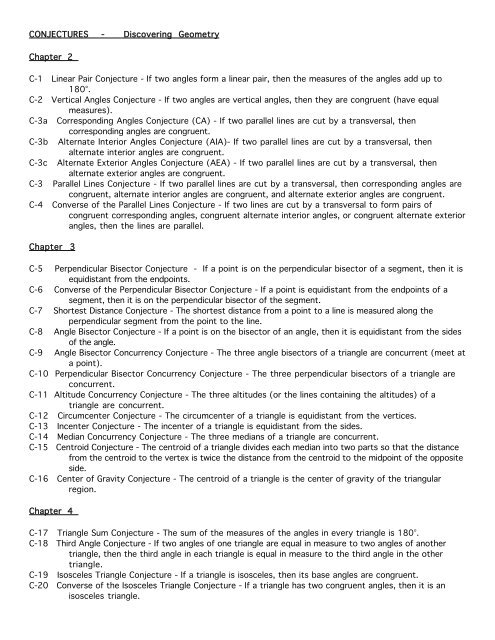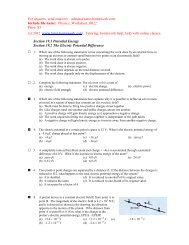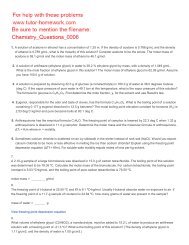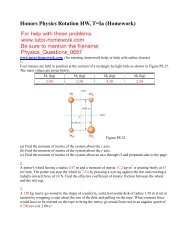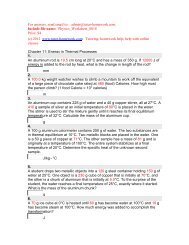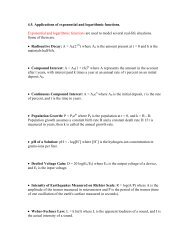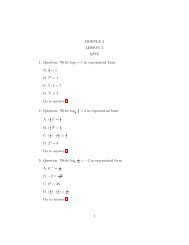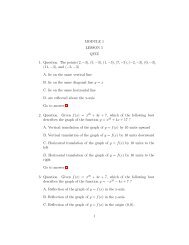CONJECTURES - Discovering Geometry Chapter 2 C-1 Linear Pair ...
CONJECTURES - Discovering Geometry Chapter 2 C-1 Linear Pair ...
CONJECTURES - Discovering Geometry Chapter 2 C-1 Linear Pair ...
You also want an ePaper? Increase the reach of your titles
YUMPU automatically turns print PDFs into web optimized ePapers that Google loves.
<strong>CONJECTURES</strong> - <strong>Discovering</strong> <strong>Geometry</strong><br />
<strong>Chapter</strong> 2<br />
C-1 <strong>Linear</strong> <strong>Pair</strong> Conjecture - If two angles form a linear pair, then the measures of the angles add up to<br />
180°.<br />
C-2 Vertical Angles Conjecture - If two angles are vertical angles, then they are congruent (have equal<br />
measures).<br />
C-3a Corresponding Angles Conjecture (CA) - If two parallel lines are cut by a transversal, then<br />
corresponding angles are congruent.<br />
C-3b Alternate Interior Angles Conjecture (AIA)- If two parallel lines are cut by a transversal, then<br />
alternate interior angles are congruent.<br />
C-3c Alternate Exterior Angles Conjecture (AEA) - If two parallel lines are cut by a transversal, then<br />
alternate exterior angles are congruent.<br />
C-3 Parallel Lines Conjecture - If two parallel lines are cut by a transversal, then corresponding angles are<br />
congruent, alternate interior angles are congruent, and alternate exterior angles are congruent.<br />
C-4 Converse of the Parallel Lines Conjecture - If two lines are cut by a transversal to form pairs of<br />
congruent corresponding angles, congruent alternate interior angles, or congruent alternate exterior<br />
angles, then the lines are parallel.<br />
<strong>Chapter</strong> 3<br />
C-5 Perpendicular Bisector Conjecture - If a point is on the perpendicular bisector of a segment, then it is<br />
equidistant from the endpoints.<br />
C-6 Converse of the Perpendicular Bisector Conjecture - If a point is equidistant from the endpoints of a<br />
segment, then it is on the perpendicular bisector of the segment.<br />
C-7 Shortest Distance Conjecture - The shortest distance from a point to a line is measured along the<br />
perpendicular segment from the point to the line.<br />
C-8 Angle Bisector Conjecture - If a point is on the bisector of an angle, then it is equidistant from the sides<br />
of the angle.<br />
C-9 Angle Bisector Concurrency Conjecture - The three angle bisectors of a triangle are concurrent (meet at<br />
a point).<br />
C-10 Perpendicular Bisector Concurrency Conjecture - The three perpendicular bisectors of a triangle are<br />
concurrent.<br />
C-11 Altitude Concurrency Conjecture - The three altitudes (or the lines containing the altitudes) of a<br />
triangle are concurrent.<br />
C-12 Circumcenter Conjecture - The circumcenter of a triangle is equidistant from the vertices.<br />
C-13 Incenter Conjecture - The incenter of a triangle is equidistant from the sides.<br />
C-14 Median Concurrency Conjecture - The three medians of a triangle are concurrent.<br />
C-15 Centroid Conjecture - The centroid of a triangle divides each median into two parts so that the distance<br />
from the centroid to the vertex is twice the distance from the centroid to the midpoint of the opposite<br />
side.<br />
C-16 Center of Gravity Conjecture - The centroid of a triangle is the center of gravity of the triangular<br />
region.<br />
<strong>Chapter</strong> 4<br />
C-17 Triangle Sum Conjecture - The sum of the measures of the angles in every triangle is 180°.<br />
C-18 Third Angle Conjecture - If two angles of one triangle are equal in measure to two angles of another<br />
triangle, then the third angle in each triangle is equal in measure to the third angle in the other<br />
triangle.<br />
C-19 Isosceles Triangle Conjecture - If a triangle is isosceles, then its base angles are congruent.<br />
C-20 Converse of the Isosceles Triangle Conjecture - If a triangle has two congruent angles, then it is an<br />
isosceles triangle.
C-21 Triangle Inequality Conjecture - The sum of the lengths of any two sides of a triangle is greater than the<br />
length of the third side.<br />
C-22 Side-Angle Inequality Conjecture - In a triangle, if one side is longer than another side, then the angle<br />
opposite the longer side is larger than the angle opposite the shorter side.<br />
C-23 Triangle Exterior Angle Conjecture - The measure of an exterior angle of a triangle is equal to the sum<br />
of the measures of the remote interior angles.<br />
C-24 SSS Congruence Conjecture - If the three sides of one triangle are congruent to the three sides of<br />
another triangle, then the triangles are congruent.<br />
C-25 SAS Congruence Conjecture - If two sides and the included angle of one triangle are congruent to two<br />
sides and the included angle of another triangle, then the triangles are congruent.<br />
C-26 ASA Congruence Conjecture - If two angles and the included side of one triangle are congruent to two<br />
angles and the included side of another triangle, then the triangles are congruent.<br />
C-27 SAA Congruence Conjecture - If two angles and a non-included side of one triangle are congruent to the<br />
corresponding angles and side of another triangle, then the triangles are congruent.<br />
C-28 Vertex Angle Bisector Conjecture - In an isosceles triangle, the bisector of the vertex angle is also the<br />
altitude and the median to the base.<br />
C-29 Equilateral/Equiangular Triangle Conjecture - Every equilateral triangle is equiangular. Conversely,<br />
every equiangular triangle is equilateral.<br />
<strong>Chapter</strong> 5<br />
C-30 Quadrilateral Sum Conjecture - The sum of the measures of the four angles of any quadrilateral is<br />
360°.<br />
C-31 Pentagon Sum Conjecture - The sum of the measures of the five angles of any pentagon is 540°.<br />
C-32 Polygon Sum Conjecture - The sum of the measures of the n interior angles of an n-gon is (n - 2) •180 .<br />
C-33 Exterior Angle Sum Conjecture - For any polygon, the sum of the measures of a set of exterior angles is<br />
360°.<br />
C-34 Equiangular Polygon Conjecture - You can find the measure of each interior angle of an equiangular n-<br />
(n - 2) •180<br />
gon by using either of these formulas:<br />
∞<br />
or 180 -<br />
n<br />
360∞<br />
Ê<br />
ˆ<br />
Ë n ¯<br />
C-35 Kite Angles Conjecture - The non-vertex angles of a kite are congruent.<br />
C-36 Kite Diagonals Conjecture - The diagonals of a kite are perpendicular.<br />
C-37 Kite Diagonal Bisector Conjecture - The diagonal connecting the vertex angles of a kite is the<br />
perpendicular bisector of the other diagonal.<br />
C-38 Kite Angle Bisector Conjecture - The vertex angles of a kite are bisected by a diagonal.<br />
C-39 Trapezoid Consecutive Angles Conjecture - The consecutive angles between the bases of a trapezoid are<br />
supplementary.<br />
C-40 Isosceles Trapezoid Conjecture - The base angles of an isosceles trapezoid are congruent.<br />
C-41 Isosceles Trapezoid Diagonals Conjecture - The diagonals of an isosceles trapezoid are congruent.<br />
C-42 Three Midsegments Conjecture - The three midsegments of a triangle divide it into four congruent<br />
triangles.<br />
C-43 Triangle Midsegment Conjecture - A midsegment of a triangle is parallel to the third side and half the<br />
length of the third side.<br />
C-44 Trapezoid Midsegment Conjecture - The midsegment of a trapezoid is parallel to the bases and is equal<br />
in length to the average of the lengths of the bases.<br />
C-45 Parallelogram Opposite Angles Conjecture - The opposite angles of a parallelogram are congruent.<br />
C-46 Parallelogram Consecutive Angles Conjecture - The consecutive angles of a parallelogram are<br />
supplementary.<br />
C-47 Parallelogram Opposite Sides Conjecture - The opposite sides of a parallelogram are congruent.<br />
C-48 Parallelogram Diagonals Conjecture - The diagonals of a parallelogram bisect each other.<br />
C-49 Double-Edged Straightedge Conjecture - If two parallel lines are intersected by a second pair of<br />
parallel lines that are the same distance apart as the first pair, then the parallelogram formed is a<br />
rhombus.
C-50 Rhombus Diagonals Conjecture - The diagonals of a rhombus are perpendicular and they bisect each<br />
other.<br />
C-51 Rhombus Angles Conjecture - The diagonals of a rhombus bisect the angles of the rhombus.<br />
C-52 Rectangle Diagonals Conjecture - The diagonals of a rectangle are congruent and bisect each other.<br />
C-53 Square Diagonals Conjecture - The diagonals of a square are congruent, perpendicular,and bisect each<br />
other.<br />
<strong>Chapter</strong> 6<br />
C-54 Chord Central Angles Conjecture - If two chords in a circle are congruent, then they determine two<br />
central angles that are congruent.<br />
C-55 Chord Arcs Conjecture - If two chords in a circle are congruent, then their intercepted arcs are<br />
congruent.<br />
C-56 Perpendicular to a Chord Conjecture - The perpendicular from the center of a circle to a chord is the<br />
bisector of the chord.<br />
C-57 Chord Distance to Center Conjecture - Two congruent chords in a circle are equidistant from the center<br />
of the circle.<br />
C-58 Perpendicular Bisector of a Chord Conjecture - The perpendicular bisector of a chord passes through<br />
the center of the circle.<br />
C-59 Tangent Conjecture - A tangent to a circle is perpendicular to the radius drawn to the point of tangency.<br />
C-60 Tangent Segments Conjecture - Tangent segments to a circle from a point outside the circle are<br />
congruent.<br />
C-61 Inscribed Angle Conjecture - The measure of an angle inscribed in a circle is one-half the measure of<br />
the central angle.<br />
C-62 Inscribed Angles Intercepting Arcs Conjecture - Inscribed angles that intercept the same arc are<br />
congruent.<br />
C-63 Angles Inscribed in a Semicircle Conjecture - Angles inscribed in a semicircle are right angles.<br />
C-64 Cyclic Quadrilateral Conjecture - The opposite angles of a cyclic quadrilateral are supplementary.<br />
C-65 Parallel Lines Intercepted Arcs Conjecture - Parallel lines intercept congruent arcs on a circle.<br />
C-66 Circumference Conjecture - If C is the circumference and d is the diameter of a circle, then there is a<br />
number such that C=πd. If d=2r where r is the radius, then C=2πr.<br />
C-67 Arc Length Conjecture - The length of an arc equals the circumference times the measure of the central<br />
angle divided by 360°.<br />
<strong>Chapter</strong> 7<br />
C-68 Reflection Line Conjecture - The line of reflection is the perpendicular bisector of every segment<br />
joining a point in the original figure with its image.<br />
C-69 Coordinate Transformations Conjecture<br />
The ordered pair rule (x, y)?(x, y) is a reflection over the y-axis.<br />
The ordered pair rule (x, y)?(x, y) is a reflection over the x-axis.<br />
The ordered pair rule (x, y)?(x, y) is a rotation about the origin.<br />
The ordered pair rule (x, y)?(y, x) is a reflection over y=x<br />
C-70 Minimal Path Conjecture - If points A and B are on one side of line l, then the minimal path from point<br />
A to line l to point B is found by reflecting point B over line l, drawing segment A B ¢ , then drawing<br />
segments AC and CB where point C is the point of intersection of segment A B ¢ and line l.<br />
C-71 Reflections over Parallel Lines Conjecture - A composition of two reflections over two parallel lines is<br />
equivalent to a single translation. In addition, the distance from any point to its second image under<br />
the two reflections is twice the distance between the parallel lines.<br />
C-72 Reflections over Intersecting Lines Conjecture - A composition of two reflections over a pair of<br />
intersecting lines is equivalent to a single rotation. The angle of rotation is twice the acute angle<br />
between the pair of intersecting reflection lines.<br />
C-73 Tessellating Triangles Conjecture - Any triangle will create a monohedral tessellation.<br />
C-74 Tessellating Quadrilaterals Conjecture - Any quadrilateral will create a monohedral tessellation.
<strong>Chapter</strong> 8<br />
C-75 Rectangle Area Conjecture - The area of a rectangle is given by the formula A=bh, where A is the area,<br />
b is the length of the base, and h is the height of the rectangle.<br />
C-76 Parallelogram Area Conjecture - The area of a parallelogram is given by the formula A=bh, where A is<br />
the area, b is the length of the base, and h is the height of the parallelogram.<br />
C-77 Triangle Area Conjecture - The area of a triangle is given by the formula A = bh<br />
, where A is the area,<br />
2<br />
b is the length of the base, and h is the height of the triangle.<br />
C-78 Trapezoid Area Conjecture - The area of a trapezoid is given by the formula A = (b1 + b2 )h<br />
where A is<br />
2<br />
the area, b1 and b2 are the lengths of the two bases, and h is the height of the trapezoid.<br />
C-79 Kite Area Conjecture - The area of a kite is given by the formula<br />
A = d 1 ∑d 2<br />
2<br />
where d1 and d2 are the<br />
lengths of the diagonals<br />
C-80 Regular Polygon Area Conjecture - The area of a regular polygon is given by the formula A=asn, where<br />
A is the area, a is the apothem, s is the length of each side, and n is the number of sides. The length of<br />
each side times the number of sides is the perimeter P, so sn =P. So the formula for area is also:<br />
a ∑ P<br />
A =<br />
2<br />
C-81 Circle Area Conjecture - The area of a circle is given by the formula A=πr 2 , where A is the area and r<br />
is the radius of the circle.<br />
C-82 The Pythagorean Theorem - In a right triangle, the sum of the squares of the lengths of the legs equals<br />
the square of the length of the hypotenuse. If a and b are the lengths of the legs, and c is the length of<br />
the hypotenuse, then a2 +b2 =c2 .<br />
C-83 Converse of the Pythagorean Theorem - If the lengths of the three sides of a triangle satisfy the<br />
Pythagorean equation, then the triangle is a right triangle.<br />
C-84 Isosceles Right Triangle Conjecture - In an isosceles right triangle, if the legs have length s, then the<br />
hypotenuse has length s • 2<br />
C-85 30°-60°-90° Triangle Conjecture - In a 30°-60°-90° triangle, if the shorter leg has length a, then<br />
the longer leg has length a ∑ 3 , and the hypotenuse has length 2a.<br />
C-86 Distance Formula - The distance between points A(x1 ,y1 ) and B(x2 , y2 ) is given by<br />
AB = (x 2 - x 1 ) 2 + (y 2 - y 1 ) 2<br />
C-87 Equation of a Circle - The equation of a circle with radius r and center (h, k) is<br />
<strong>Chapter</strong> 10<br />
(x - h) 2 +(y - k) 2 = r 2<br />
C-88a Conjecture A - If B is the area of the base of a right rectangular prism and H is the height of the solid,<br />
then the formula for the volume is V=BH.<br />
C-88b Conjecture B - If B is the area of the base of a right prism (or cylinder) and H is the height of the<br />
solid, then the formula for the volume is V = BH.<br />
C-88c Conjecture C - The volume of an oblique prism (or cylinder) is the same as the volume of a right<br />
prism (or cylinder) that has the same base area and the same height.<br />
C-88 Prism-Cylinder Volume Conjecture - The volume of a prism or a cylinder is the area of the base<br />
multiplied by the height, V = B • H .<br />
C-89 Pyramid-Cone Volume Conjecture - If B is the area of the base of a pyramid or a cone and H is the<br />
height of the solid, then the formula for the volume is V =<br />
B • H<br />
.<br />
3<br />
C-90 Sphere Volume Conjecture - The volume of a sphere with radius r is given by the formula V =<br />
4 pr3<br />
3 .
C-91 Sphere Surface Area Conjecture - The surface area, SA, of a sphere with radius r is given by the<br />
formula SA = 4pr 2<br />
<strong>Chapter</strong> 11<br />
C-92 Dilation Similarity Conjecture - If one polygon is the image of another polygon under a dilation, then<br />
the polygons are similar.<br />
C-93 AA Similarity Conjecture - If two angles of one triangle are congruent to two angles of another triangle,<br />
then the triangles are similar.<br />
C-94 SSS Similarity Conjecture - If the three sides of one triangle are proportional to the three sides of<br />
another triangle, then the two triangles are similar.<br />
C-95 SAS Similarity Conjecture - If two sides of one triangle are proportional to two sides of another<br />
triangle and the included angles are congruent, then the triangles are similar.<br />
C-96 Proportional Parts Conjecture - If two triangles are similar, then the corresponding altitudes,<br />
medians, and angle bisectors are proportional to the corresponding sides.<br />
C-97 Angle Bisector/Opposite Side Conjecture - A bisector of an angle in a triangle divides the opposite side<br />
into two segments whose lengths are in the same ratio as the lengths of the two sides forming the<br />
angle.<br />
C-98 Proportional Areas Conjecture - If corresponding sides of two similar polygons or the radii of two<br />
2<br />
m<br />
Ê mˆ<br />
circles compare in the ratio , then their areas compare in the ratio<br />
n Ë n ¯<br />
C-99 Proportional Volumes Conjecture - If corresponding edges (or radii, or heights) of two similar solids<br />
3<br />
m<br />
Ê mˆ<br />
compare in the ratio , then their volumes compare in the ratio of .<br />
n Ë n ¯<br />
C-100 Parallel/Proportionality Conjecture - If a line parallel to one side of a triangle passes through the<br />
other two sides, then it divides the other two sides proportionally. Conversely, if a line cuts two<br />
sides of a triangle proportionally, then it is parallel to the third side.<br />
C-101 Extended Parallel/Proportionality Conjecture - If two or more lines pass through two sides of a<br />
triangle parallel to the third side, then they divide the two sides proportionally.<br />
<strong>Chapter</strong> 12<br />
C-102 SAS Triangle Area Conjecture - The area of a triangle is given by the formula<br />
a and b are the lengths of two sides and C is the angle between them.<br />
C-103 Law of Sines - For a triangle with angles A, B, and C and sides of lengths a, b,<br />
and c (a is opposite A, b is opposite B, and c is opposite C),<br />
C-104 Pythagorean Identity - For any angle A,<br />
( sin A)<br />
2 + ( CosA)<br />
2 = 1<br />
SinA<br />
a<br />
= SinB<br />
b<br />
A =<br />
1<br />
2 ab<br />
Ê ˆ<br />
sinC , where<br />
Ë ¯<br />
= SinC<br />
c<br />
C-105 Law of Cosines - For any triangle with sides of lengths a, b, and c, and with C the angle opposite the<br />
side with length c, c 2 = a 2 + b 2 - (2ab)cosC


